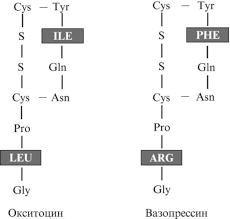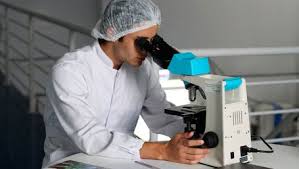
Peptide hormones
Peptides or protein hormones are substances composed of amino acid chains or proteins. They are synthesized in the form of prehormones and become active only after further modification. As hormones, they are substances that control cellular metabolism. They work very differently as they have different functions and regulate different metabolic processes.
The structure of amino acid chains determines different mechanisms of action compared to other hormones such as steroids. In fact, due to polarity and large molecular size due to their nature, they are not able to cross cell membranes, hence they have receptors located on the membranes themselves (transmembrane receptors), moreover, they have a short lifespan as they are rapidly metabolized as in circle what’s inside cells, in inactive amino acids and peptides.
With the birth of biotechnology, it has become possible to create in the laboratory biosynthetic forms of these proteins and new compounds of the same, obtained with minor modifications in amino acid chains or by chelating with metals or even glycosylating the same, these structural modifications seek to improve stability and activity .

Like all proteins, peptide ( https://steroide24.com/shop/peptidpraparate) hormones are also synthesized inside cells, starting with the genetic code, and then stored in vesicles and secreted by exocytosis.
Protid hormones travel through the bloodstream until they reach target cells. Here, being polar, they do not penetrate the membrane, but bind to certain transmembrane receptors. Peptide hormone receptors are metabotropic and therefore regulate cellular metabolism by activating certain cellular functions such as gene transcription, enzyme functionality, etc. At the moment when peptide hormones bind the receptor, a new complex complex activates second intracellular messengers generated by certain enzymes such as adenylate cyclase and phospholipase C, which amplify the signal by stimulating a cascade of reactions. intracellular is able to activate all enzymes necessary for hormonal response.
The intracellular responses generated by these hormones are very diverse, as they act on very different cells and biochemical functions.
Protein hormones have a short half-life and therefore also a short activity (usually a few minutes), since the amino acid chains of which they are composed are rapidly metabolized by the liver or target cells when the hormone-receptor complex is endocytosed by the cell itself. p>
With regard to steroid hormones, protein hormones can also be introduced exogenously into the body to create replacement therapy when the same is lacking. This type of therapy is usually carried out using hormones similar to those produced by the body, however, it is possible to modify these essential substances by replacing some amino acids or removing part of the peptide chain because it does not function to work, or by making appropriate modifications. as glycosylation to create hormones that are more active or more stable in the body.

Due to the peptide nature of these substances, the modes of administration significantly affect their activity, in fact, if taken orally. Due to the first pass effect in the liver and gastrointestinal tract, these substances are rapidly metabolized by enzymatic hydrolysis of the peptide bond. For this reason, oral administration is not very effective.
In addition, intramuscular injection also involves the rapid metabolism of these substances, since muscle cells also have enzymes responsible for hydrolysis of the peptide bond. Therefore, peptide hormones are usually administered by subcutaneous or intravenous injection, so that substances enter the bloodstream without passing through the tissues, and therefore can perform their effect. Some of these hormones are administered with a nasal spray that allows their absorption by the lung epithelium.
Among these hormones, there are numerous substances that can affect:
- Protein Synthesis
- cellular trophism of muscle and bone tissue
- hematopoiesis
- muscle capacity
- the production and use of energy by the body
- tissue vascularization
- regenerative abilities
- activation and differentiation of stem cells
- activity of other hormones responsible for one or more of the above effects
Substances capable of acting in the aforementioned ways are capable of modifying a person’s physical abilities and, consequently, the athletic ability and ability of an athlete, for this reason a certain amount of protein hormones and substances that mimic his activity are prohibited by anti-doping rules.
Anti-Doping Regulated Peptides:
- Erythropoiesis stimulating agents: erythropoietin (EPO), darbepoetin, (dEPO), hypoxia-inducible factor (HIF) stabilizers), methoxypolyethylene glycol-epoetin beta (CERA), peginesatide / (hematide) li>
- gonadotropins: chorionic gonadotropin (CG), gonadorelin and luteinizing hormone (LH) are prohibited in men
- Insulins
- Corticotrophins
- Growth hormone and growth factors: GH, insulin-like growth factor (IGF-1), fibroblast growth factors (FGFs), hepatocyte growth factors (HGF), mechanical growth factors (MGFs) platelet growth factors (PDGF), endothelial growth factor vascular (VEGF) and any other growth factor that affects the synthesis / breakdown of proteins, muscles, tendons or ligaments, vascularization, energy use, regenerative capacity and differentiation of muscle fiber type
- Other substances with a similar chemical structure or similar biological effect (s)
In accordance with the legislation – doping, a sample will be considered containing a prohibited substance if the concentration of the substance or its metabolites is clearly different from the values usually found in humans. In some cases, and only with proper medical clearance, the use of insulin is only permitted for the treatment of type I diabetes.
It is especially difficult to trace these substances as expected, being peptide in nature, they are rapidly metabolized by the body into amino acids, therefore, the metabolites themselves are substances naturally present in the body (amino acids), therefore they cannot be used as a trace of consumption substances. Since there are no specific metabolites like stimulants, steroid diuretics, etc., the doping test is especially difficult to perform. It is also for this reason that these substances are increasingly used by athletes.
Currently, antibodies are used in detection tests that specifically bind to each hormone, antibody-hormone complexes are then detected using immunological analysis, this type of study implies the presence of the hormone itself, which, after metabolism, is no more traceable. For this reason, detection of an athlete’s intended use of an exogenous peptide hormone is only possible when the substance is still present in the body.

Agents that stimulate erythropoiesis
Oxygen is an essential element of life, and the body has developed an improved method of collecting it in the lungs and transporting it to tissues. This method is based on the affinity of hemoglobin for oxygen itself. Erythrocytes are special cells with the function of transporting oxygen in the body. the activity of erythrocytes is based on the production and presence of hemoglobin in them. Therefore, hemoglobin is a protein molecule contained in red blood cells responsible for the transport of oxygen in the blood. This protein binds oxygen in the lungs and delivers it to all body tissues.
The presence of oxygen plays a critical role in athletic performance, and the agents are capable of Increasing the release and transport of oxygen to the tissue allows for increased aerobic strength and endurance in endurance sports and in mixed energy efforts.
